brake sensor CITROEN C3 AIRCROSS 2023 Owners Manual
[x] Cancel search | Manufacturer: CITROEN, Model Year: 2023, Model line: C3 AIRCROSS, Model: CITROEN C3 AIRCROSS 2023Pages: 244, PDF Size: 7.09 MB
Page 87 of 244
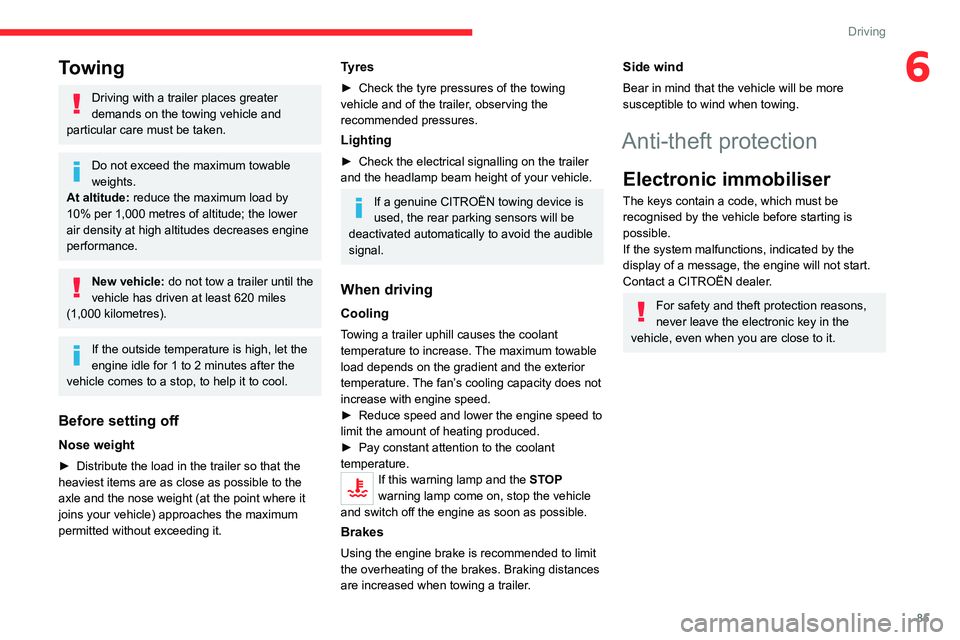
85
Driving
6Towing
Driving with a trailer places greater
demands on the towing vehicle and
particular care must be taken.
Do not exceed the maximum towable
weights.
At altitude: reduce the maximum load by
10% per 1,000 metres of altitude; the lower
air density at high altitudes decreases engine
performance.
New vehicle: do not tow a trailer until the
vehicle has driven at least 620 miles
(1,000 kilometres).
If the outside temperature is high, let the
engine idle for 1 to 2 minutes after the
vehicle comes to a stop, to help it to cool.
Before setting off
Nose weight
► Distribute the load in the trailer so that the
heaviest items are as close as possible to the
axle and the nose weight (at the point where it
joins your vehicle) approaches the maximum
permitted without exceeding it.
Tyres
► Check the tyre pressures of the towing
vehicle and of the trailer , observing the
recommended pressures.
Lighting
► Check the electrical signalling on the trailer
and the headlamp beam height of your vehicle.
If a genuine CITROËN towing device is
used, the rear parking sensors will be
deactivated automatically to avoid the audible
signal.
When driving
Cooling
Towing a trailer uphill causes the coolant
temperature to increase. The maximum towable
load depends on the gradient and the exterior
temperature. The fan’s cooling capacity does not
increase with engine speed.
►
Reduce speed and lower the engine speed to
limit the amount of heating produced.
►
Pay constant attention to the coolant
temperature.
If this warning lamp and the STOP
warning lamp come on, stop the vehicle
and switch off the engine as soon as possible.
Brakes
Using the engine brake is recommended to limit
the overheating of the brakes. Braking distances
are increased when towing a trailer.
Side wind
Bear in mind that the vehicle will be more
susceptible to wind when towing.
Anti-theft protection
Electronic immobiliser
The keys contain a code, which must be
recognised by the vehicle before starting is
possible.
If the system malfunctions, indicated by the
display of a message, the engine will not start.
Contact a CITROËN dealer.
For safety and theft protection reasons,
never leave the electronic key in the
vehicle, even when you are close to it.
Page 97 of 244
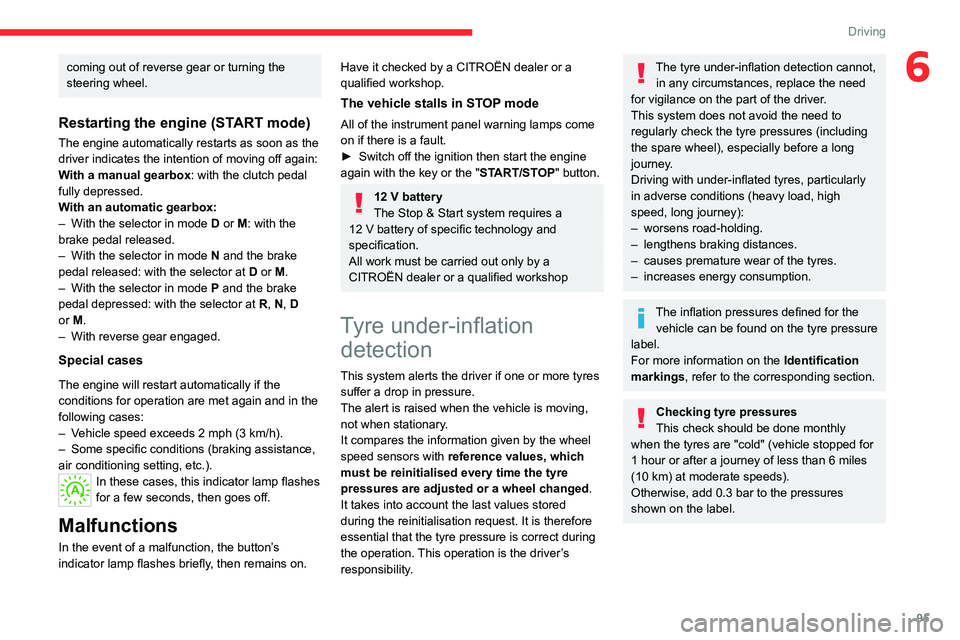
95
Driving
6coming out of reverse gear or turning the
steering wheel.
Restarting the engine (START mode)
The engine automatically restarts as soon as the
driver indicates the intention of moving off again:
With a manual gearbox: with the clutch pedal
fully depressed.
With an automatic gearbox:
–
With the selector in mode
D or M: with the
brake pedal released.
–
With the selector in mode
N and the brake
pedal released: with the selector at D or M.
–
With the selector in mode
P and the brake
pedal depressed: with the selector at R, N, D
or M.
–
With reverse gear engaged.
Special cases
The engine will restart automatically if the
conditions for operation are met again and in the
following cases:
–
V
ehicle speed exceeds 2 mph (3 km/h).
–
Some specific conditions (braking assistance,
air conditioning setting, etc.).
In these cases, this indicator lamp flashes
for a few seconds, then goes off.
Malfunctions
In the event of a malfunction, the button’s
indicator lamp flashes briefly, then remains on.
Have it checked by a CITROËN dealer or a
qualified workshop.
The vehicle stalls in STOP mode
All of the instrument panel warning lamps come
on if there is a fault.
►
Switch off the ignition then start the engine
again with the key or the " ST
ART/STOP" button.
12 V battery
The Stop & Start system requires a
12 V battery of specific technology and
specification.
All work must be carried out only by a
CITROËN dealer or a qualified workshop
Tyre under-inflation detection
This system alerts the driver if one or more tyres
suffer a drop in pressure.
The alert is raised when the vehicle is moving,
not when stationary.
It compares the information given by the wheel
speed sensors with reference values, which
must be reinitialised every time the tyre
pressures are adjusted or a wheel changed.
It takes into account the last values stored
during the reinitialisation request. It is therefore
essential that the tyre pressure is correct during
the operation. This operation is the driver’s
responsibility.
The tyre under-inflation detection cannot, in any circumstances, replace the need
for vigilance on the part of the driver.
This system does not avoid the need to
regularly check the tyre pressures (including
the spare wheel), especially before a long
journey.
Driving with under-inflated tyres, particularly
in adverse conditions (heavy load, high
speed, long journey):
–
worsens road-holding.
–
lengthens braking distances.
–
causes premature wear of the tyres.
–
increases energy consumption.
The inflation pressures defined for the vehicle can be found on the tyre pressure
label.
For more information on the Identification
markings, refer to the corresponding section.
Checking tyre pressures
This check should be done monthly
when the tyres are "cold" (vehicle stopped for
1 hour or after a journey of less than 6 miles
(10
km) at moderate speeds).
Otherwise, add 0.3 bar to the pressures
shown on the label.
Page 211 of 244
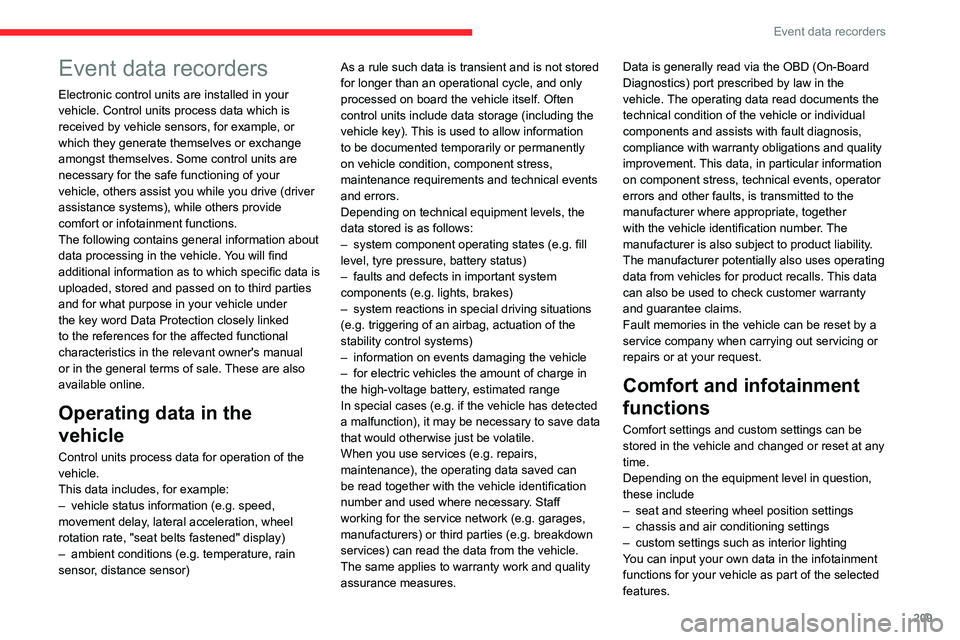
209
Event data recorders
Event data recorders
Electronic control units are installed in your
vehicle. Control units process data which is
received by vehicle sensors, for example, or
which they generate themselves or exchange
amongst themselves. Some control units are
necessary for the safe functioning of your
vehicle, others assist you while you drive (driver
assistance systems), while others provide
comfort or infotainment functions.
The following contains general information about
data processing in the vehicle. You will find
additional information as to which specific data is
uploaded, stored and passed on to third parties
and for what purpose in your vehicle under
the key word Data Protection closely linked
to the references for the affected functional
characteristics in the relevant owner's manual
or in the general terms of sale. These are also
available online.
Operating data in the
vehicle
Control units process data for operation of the
vehicle.
This data includes, for example:
–
vehicle status information (e.g. speed,
movement delay
, lateral acceleration, wheel
rotation rate, "seat belts fastened" display)
–
ambient conditions (e.g. temperature, rain
sensor
, distance sensor) As a rule such data is transient and is not stored
for longer than an operational cycle, and only
processed on board the vehicle itself. Often
control units include data storage (including the
vehicle key). This is used to allow information
to be documented temporarily or permanently
on vehicle condition, component stress,
maintenance requirements and technical events
and errors.
Depending on technical equipment levels, the
data stored is as follows:
–
system component operating states (e.g. fill
level, tyre pressure, battery status)
–
faults and defects in important system
components (e.g. lights, brakes)
–
system reactions in special driving situations
(e.g. triggering of an airbag, actuation of the
stability control systems)
–
information on events damaging the vehicle
–
for electric vehicles the amount of charge in
the high-voltage battery
, estimated range
In special cases (e.g. if the vehicle has detected
a malfunction), it may be necessary to save data
that would otherwise just be volatile.
When you use services (e.g. repairs,
maintenance), the operating data saved can
be read together with the vehicle identification
number and used where necessary. Staff
working for the service network (e.g. garages,
manufacturers) or third parties (e.g. breakdown
services) can read the data from the vehicle.
The same applies to warranty work and quality
assurance measures. Data is generally read via the OBD (On-Board
Diagnostics) port prescribed by law in the
vehicle. The operating data read documents the
technical condition of the vehicle or individual
components and assists with fault diagnosis,
compliance with warranty obligations and quality
improvement. This data, in particular information
on component stress, technical events, operator
errors and other faults, is transmitted to the
manufacturer where appropriate, together
with the vehicle identification number. The
manufacturer is also subject to product liability.
The manufacturer potentially also uses operating
data from vehicles for product recalls. This data
can also be used to check customer warranty
and guarantee claims.
Fault memories in the vehicle can be reset by a
service company when carrying out servicing or
repairs or at your request.
Comfort and infotainment
functions
Comfort settings and custom settings can be
stored in the vehicle and changed or reset at any
time.
Depending on the equipment level in question,
these include
–
seat and steering wheel position settings
–
chassis and air conditioning settings
–
custom settings such as interior lighting
Y
ou can input your own data in the infotainment
functions for your vehicle as part of the selected
features.
Page 213 of 244
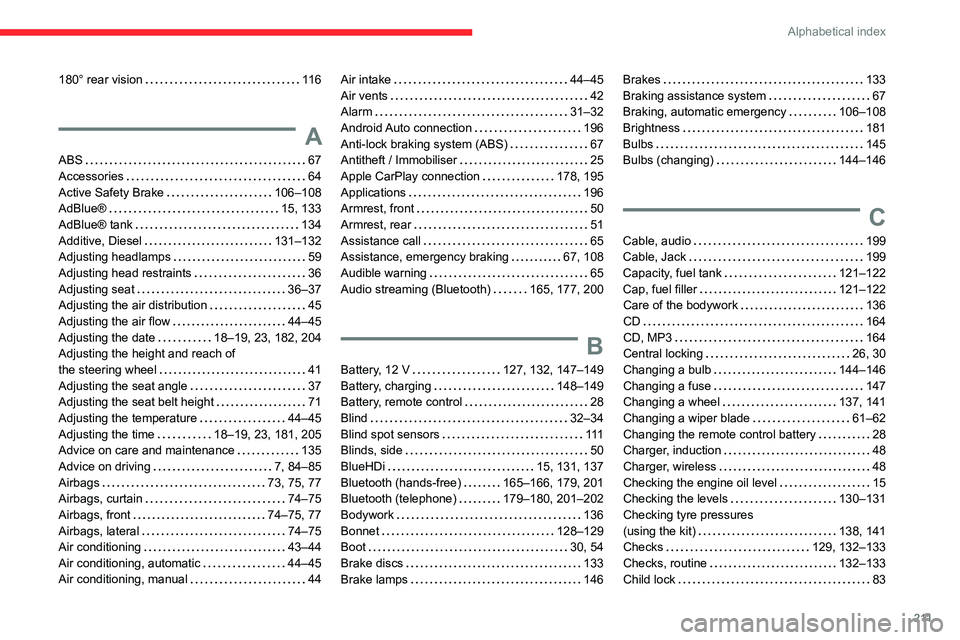
2 11
Alphabetical index
180° rear vision 11 6
A
ABS 67
Accessories
64
Active Safety Brake
106–108
AdBlue®
15, 133
AdBlue® tank
134
Additive, Diesel
131–132
Adjusting headlamps
59
Adjusting head restraints
36
Adjusting seat
36–37
Adjusting the air distribution
45
Adjusting the air flow
44–45
Adjusting the date
18–19, 23, 182, 204
Adjusting the height and reach of
the steering wheel
41
Adjusting the seat angle
37
Adjusting the seat belt height
71
Adjusting the temperature
44–45
Adjusting the time
18–19, 23, 181, 205
Advice on care and maintenance
135
Advice on driving
7, 84–85
Airbags
73, 75, 77
Airbags, curtain
74–75
Airbags, front
74–75, 77
Airbags, lateral
74–75
Air conditioning
43–44
Air conditioning, automatic
44–45
Air conditioning, manual
44
Air intake 44–45
Air vents
42
Alarm
31–32
Android Auto connection
196
Anti-lock braking system (ABS)
67
Antitheft / Immobiliser
25
Apple CarPlay connection
178, 195
Applications
196
Armrest, front
50
Armrest, rear
51
Assistance call
65
Assistance, emergency braking
67, 108
Audible warning
65
Audio streaming (Bluetooth)
165, 177, 200
B
Battery, 12 V 127, 132, 147–149
Battery, charging
148–149
Battery, remote control
28
Blind
32–34
Blind spot sensors
111
Blinds, side
50
BlueHDi
15, 131, 137
Bluetooth (hands-free)
165–166, 179, 201
Bluetooth (telephone)
179–180, 201–202
Bodywork
136
Bonnet
128–129
Boot
30, 54
Brake discs
133
Brake lamps
146
Brakes 133
Braking assistance system
67
Braking, automatic emergency
106–108
Brightness
181
Bulbs
145
Bulbs (changing)
144–146
C
Cable, audio 199
Cable, Jack
199
Capacity, fuel tank
121–122
Cap, fuel filler
121–122
Care of the bodywork
136
CD
164
CD, MP3
164
Central locking
26, 30
Changing a bulb
144–146
Changing a fuse
147
Changing a wheel
137, 141
Changing a wiper blade
61–62
Changing the remote control battery
28
Charger, induction
48
Charger, wireless
48
Checking the engine oil level
15
Checking the levels
130–131
Checking tyre pressures
(using the kit)
138, 141
Checks
129, 132–133
Checks, routine
132–133
Child lock
83
Page 216 of 244
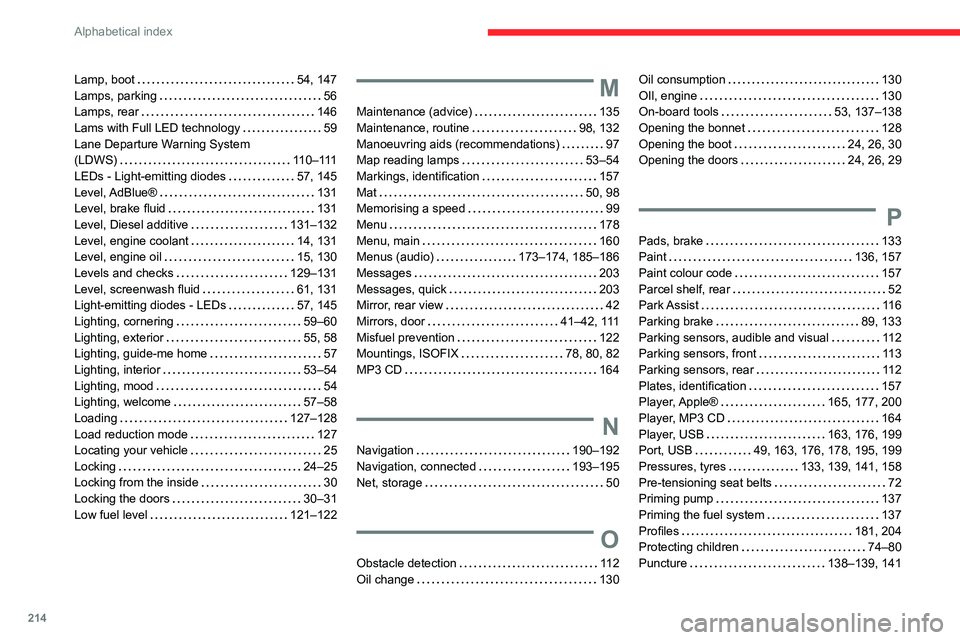
214
Alphabetical index
Lamp, boot 54, 147
Lamps, parking
56
Lamps, rear
146
Lams with Full LED technology
59
Lane Departure Warning System
(LDWS)
110–111
LEDs - Light-emitting diodes
57, 145
Level, AdBlue®
131
Level, brake fluid
131
Level, Diesel additive
131–132
Level, engine coolant
14, 131
Level, engine oil
15, 130
Levels and checks
129–131
Level, screenwash fluid
61, 131
Light-emitting diodes - LEDs
57, 145
Lighting, cornering
59–60
Lighting, exterior
55, 58
Lighting, guide-me home
57
Lighting, interior
53–54
Lighting, mood
54
Lighting, welcome
57–58
Loading
127–128
Load reduction mode
127
Locating your vehicle
25
Locking
24–25
Locking from the inside
30
Locking the doors
30–31
Low fuel level
121–122M
Maintenance (advice) 135
Maintenance, routine
98, 132
Manoeuvring aids (recommendations)
97
Map reading lamps
53–54
Markings, identification
157
Mat
50, 98
Memorising a speed
99
Menu
178
Menu, main
160
Menus (audio)
173–174, 185–186
Messages
203
Messages, quick
203
Mirror, rear view
42
Mirrors, door
41–42, 111
Misfuel prevention
122
Mountings, ISOFIX
78, 80, 82
MP3 CD
164
N
Navigation 190–192
Navigation, connected
193–195
Net, storage
50
O
Obstacle detection 11 2
Oil change
130
Oil consumption 130
OIl, engine
130
On-board tools
53, 137–138
Opening the bonnet
128
Opening the boot
24, 26, 30
Opening the doors
24, 26, 29
P
Pads, brake 133
Paint
136, 157
Paint colour code
157
Parcel shelf, rear
52
Park Assist
11 6
Parking brake
89, 133
Parking sensors, audible and visual
11 2
Parking sensors, front
113
Parking sensors, rear
11 2
Plates, identification
157
Player, Apple®
165, 177, 200
Player, MP3 CD
164
Player, USB
163, 176, 199
Port, USB
49, 163, 176, 178, 195, 199
Pressures, tyres
133, 139, 141, 158
Pre-tensioning seat belts
72
Priming pump
137
Priming the fuel system
137
Profiles
181, 204
Protecting children
74–80
Puncture
138–139, 141